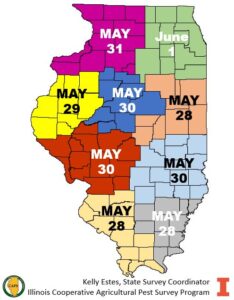Later Planting Sets Stage for Possible Black Cutworm Injury
While planting has been slow in 2022, moth flights have been steady across much of the state. Regular flights have been observed through much of the northern two-thirds of the state. Several counties have reported significant moth flights (9 or more moths over a 2-night span). We can use the date of the significant flight to predict potential cutting dates based on degree day predictions.

A few key things to note:
Black cutworm moths are strong migratory insects with northward flights commonly observed from Gulf States into the Midwest from March through May. Moths are attracted to fields heavily infested with weeds such as chickweed, shepherd’s purse, peppergrass, and yellow rocket. Late tillage and planting tends to increase the susceptibility of fields to black cutworm infestations.
Cutting of corn plants begins when larvae reach the 4th instar — with a single cutworm cutting an average of 3 to 4 plants during its larval development. Cutting tends to occur most often during nights or on dark overcast days. Fields at greatest risk to cutting and economic damage are in the 1-to-4 leaf stage of plant development.
An early warning sign of potential economic damage includes small pinhole feeding injury in leaves (caused by the first 3 instars). Producers are encouraged to look for early signs of leaf feeding as a potential indicator of cutting, rather than waiting for cutting to take place. With prolonged flights and later planted corn, feeding may continue into the early weeks of June.
Don’t assume that all Bt hybrids offer the same level of cutworm protection. Not all Bt hybrids offer adequate protection against black cutworm damage. Growers should consult the Handy Bt trait table prepared by Dr. Chris DiFonzo at Michigan State University to determine the level of protection provided by their chosen Bt hybrid. Plants in the 1- to 4-leaf stage are most susceptible to cutting. Cutting of plants earlier than these projected cutting dates is possible — localized intense flights may have occurred and were not picked up by our volunteers.
A nominal threshold of 3% cutting of plants has traditionally been used as a point at which growers should consider a rescue treatment.
For more complete information about the biology, life cycle, and management of black cutworms, a fact sheet is available from the Department of Crop Sciences, UIUC.





